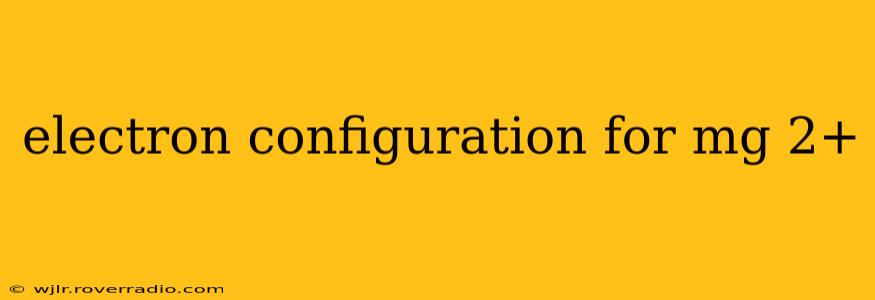Magnesium (Mg), an alkaline earth metal, plays a vital role in various biological and industrial processes. Understanding its electron configuration, especially in its ionic form (Mg²⁺), is crucial for grasping its chemical behavior and reactivity. This article will delve into the electron configuration of Mg²⁺, addressing common questions and providing a comprehensive understanding of this important ion.
What is the Electron Configuration of Magnesium (Mg)?
Before exploring the ionic state, let's establish the electron configuration of neutral magnesium. Magnesium has an atomic number of 12, meaning it possesses 12 protons and, in its neutral state, 12 electrons. These electrons fill the orbitals according to the Aufbau principle and Hund's rule. The electron configuration of neutral magnesium is therefore 1s²2s²2p⁶3s². This means it has two electrons in the 1s orbital, two in the 2s, six in the 2p, and two in the 3s orbital.
What is the Electron Configuration of Mg²⁺?
Magnesium readily loses two electrons to achieve a stable octet, forming a divalent cation, Mg²⁺. This is because losing these two electrons leaves it with a full outer shell (the 2p shell), which is a highly stable configuration. The loss of these electrons occurs from the highest energy level, which in magnesium is the 3s orbital.
Therefore, the electron configuration of Mg²⁺ is 1s²2s²2p⁶. This is isoelectronic with neon (Ne), meaning it has the same electron configuration as a neon atom. This stable configuration explains Mg's reactivity and tendency to form ionic compounds.
How is Mg²⁺ Formed?
Mg²⁺ formation involves the ionization of magnesium. This process requires energy (ionization energy) to overcome the electrostatic attraction between the positively charged nucleus and the negatively charged electrons. The first ionization energy removes one 3s electron, and the second ionization energy removes the second 3s electron. Further ionization requires significantly more energy and is less likely to occur under normal chemical conditions.
What are the Properties of Mg²⁺?
The Mg²⁺ ion, with its stable electron configuration, exhibits specific properties:
- High charge density: The 2+ charge concentrated on a relatively small ion leads to strong electrostatic interactions with other ions and molecules.
- Solubility: Mg²⁺ salts are often soluble in water, owing to the strong hydration energy of the ion.
- Biological significance: Mg²⁺ plays a crucial role in many biological systems, acting as a cofactor for numerous enzymes and participating in processes such as DNA replication and muscle contraction.
Why is the Electron Configuration of Mg²⁺ Important?
Understanding the electron configuration of Mg²⁺ is crucial for:
- Predicting chemical reactivity: The stable octet explains why magnesium readily forms ionic compounds.
- Explaining chemical bonding: The electrostatic attraction between Mg²⁺ and anions forms the basis of ionic bonding.
- Understanding biological functions: The properties of Mg²⁺ directly relate to its biological roles.
What are some common compounds containing Mg²⁺?
Magnesium ions form a variety of compounds with different anions. Some examples include magnesium oxide (MgO), magnesium chloride (MgCl₂), and magnesium sulfate (MgSO₄). The properties of these compounds are largely determined by the interactions between the Mg²⁺ ion and the corresponding anion.
This detailed explanation clarifies the electron configuration of Mg²⁺ and its significance in various contexts. The stable, isoelectronic configuration with neon is a key feature that governs the chemical and biological behavior of this important ion.
